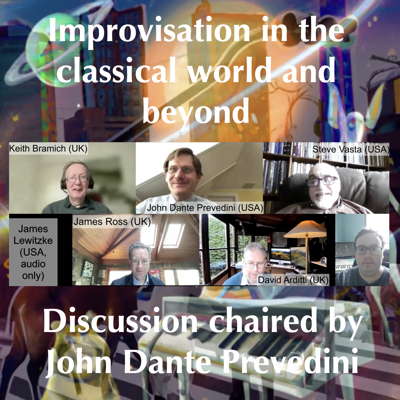 DISCUSSION: John Dante Prevedini leads a discussion about Improvisation in the classical world and beyond, including contributions from David Arditti, James Lewitzke, James Ross and Steve Vasta.
DISCUSSION: John Dante Prevedini leads a discussion about Improvisation in the classical world and beyond, including contributions from David Arditti, James Lewitzke, James Ross and Steve Vasta.
- mediaeval
- Kuschnerova
- Ann Murray
- Berio
- Charlotte Marie Louise Durey
- Edward Downes
- Ken Taylor
- Maddy Aldis-Evans
 DISCUSSION: John Dante Prevedini leads a discussion about Composers, individuals or collective?, including contributions from David Arditti, Halida Dinova, Robert McCarney and Jane Stanley.
DISCUSSION: John Dante Prevedini leads a discussion about Composers, individuals or collective?, including contributions from David Arditti, Halida Dinova, Robert McCarney and Jane Stanley.
Absolute Brahms
Nineteenth century chamber music in Rome, heard by GIUSEPPE PENNISI
Saturday 28 January 2023 at the Aula Magna of La Sapienza University in Rome - row 1, seats 26 and 24 - the usual place for my wife and I to listen to the concerts of the Istituzione Universitaria dei Concerti (IUC), now in its seventy-eighth season. Without a doubt, among the musical institutions of the Italian Capital, the IUC offers the most stimulating and therefore most crowded program, especially of chamber music.
Still quartets, or rather a quartet and a quintet, were on offer, almost immediately after the third episode of the complete quartets of Dmitri Shostakovich (1906-1975) in which the Prometeo Quartet ventured with those of 1956-1960; the review was published here on 28 January. In the IUC concert, we jump back about a century, to the heart of Romanticism, to face the production of Johannes Brahms (1833-1897) at a very delicate moment. The piano enters string quartet and quintet with the function of guide and spur, as well as multiplier of the sound power and versatility of the ensemble.
The program included the Quartet No 1 in G minor, Op 25 and the Quintet in F minor for piano and strings; these works had their debuts in 1861 and 1865, respectively. The ensemble consisted of Giorgia Tommasi (piano), Gabriele Pieranunzi (violin), Fabrizio Falasca (violin), Francesco Fiore (viola) and Danilo Squitieri (cello) - all well-known artists internationally. Vatican Radio recorded the concert and will broadcast it all over the world.
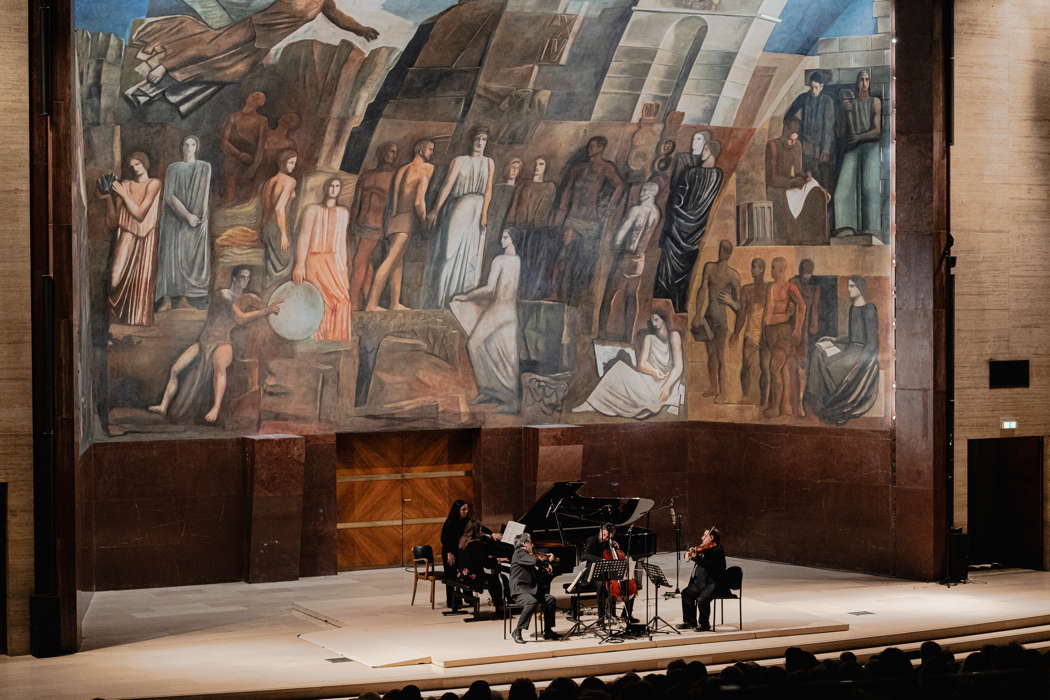
Giorgia Tommasi and friends performing at the Aula Magna of La Sapienza University in Rome. Photo © 2023 Andrea Caramelli
The G minor Quartet was first performed in the Hamburg concert hall, with Clara Schumann sitting at the piano. The reception by both the public and the critics was very benevolent, even if there were the first more or less poisonous javelins launched by the fierce Viennese critic against Brahms, who would have had to wait many years to be considered a musician of great stature in German-speaking countries.
The work is of large proportions and quite elaborate instrumentally, with the piano in a dominant position, while fully respecting the contrapuntal game with the strings. The first half imposed itself on listening both for the variety of themes - there are three - and for the richness of the musical discourse, wrapped in an atmosphere of sweet and affectionate melancholy, typically Brahmsian. An introduction based on the first theme is followed by an exposition on the three main themes; in the development, the composer uses only the first theme, followed by a re-exposition with all three themes, and the Allegro ends with a coda of classical linearity.
The Intermezzo (Allegro ma non troppo) is a page of delicate lyricism, all suffused with a feeling of autumn poetry; the central episode, slightly more lively in its evanescent and chiaroscuro sounds, is significant.
The Andante con moto opens with a warm and relaxed violin melody, projected with intensity of vibrations and enthralling the other instruments with it. In the second part of the movement the expressive atmosphere becomes vigorous and martial, almost an echo of German songs and hymns of popular extraction. The Andante ends with a return to the same dreamy initial weaving.
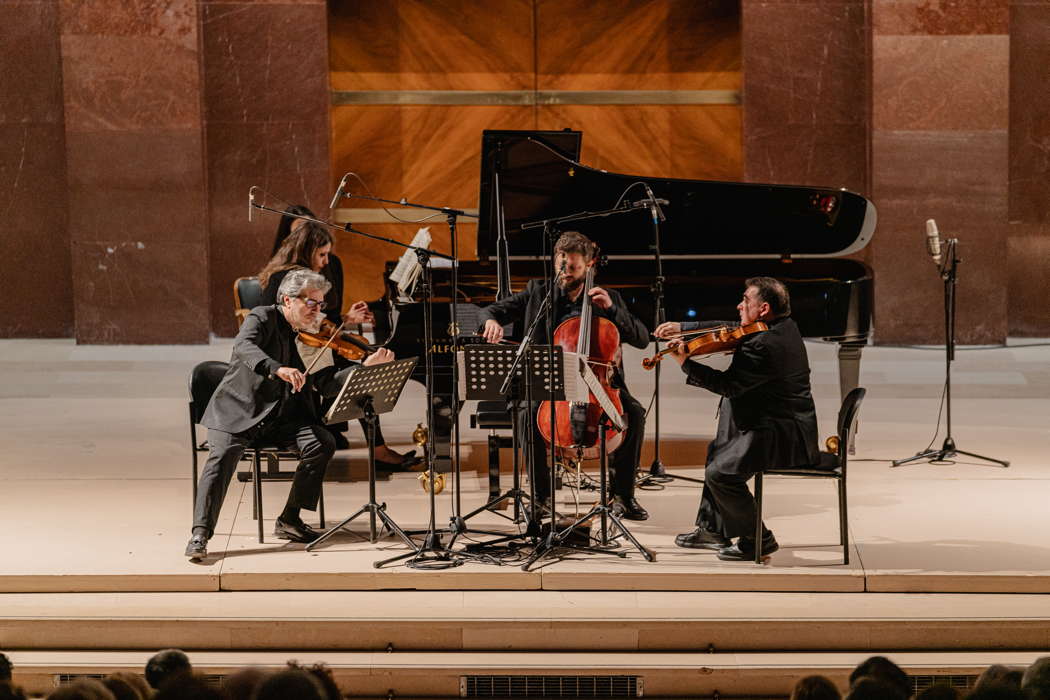
Giorgia Tommasi at the piano with, from left to right, Gabriele Pieranunzi, Danilo Squitieri and Francesco Fiore performing at the Aula Magna of La Sapienza University in Rome. Photo © 2023 Andrea Caramelli
The last tempo is a wild Rondo of gypsy character, which is linked to the spirit of those Hungarian dances so well transcribed by Brahms, who as a young man had made numerous concert tours with the famous Budapest violinist, Ede Reményi. Twice among the festive and overwhelming rhythms of gypsy music peeps a curious cadence, depicting an unexpected handshake between Bach and Liszt.
This was a very good reading by the ensemble from the opening of the initial Allegro by Giorgia Tomassi to the majestic strings and the melodic flow of the cello, full of warmth. There were excellent rhythmic and contrapuntal combinations.
The history of the composition of the Quintet in F minor for piano and strings is complex. Initially conceived for a five-string ensemble (with two cellos), Clara Schumann noted the evident imbalance between the grandiose musical content and the instrumental jacket chosen to express it. Brahms began the reworking of the musical material in the form of a sonata for two pianos. The return to the keyboard, with which Brahms was more familiar, is explained precisely in reference to that need for sound fullness that the strings alone could not render. Nonetheless, even this version was not satisfactory.
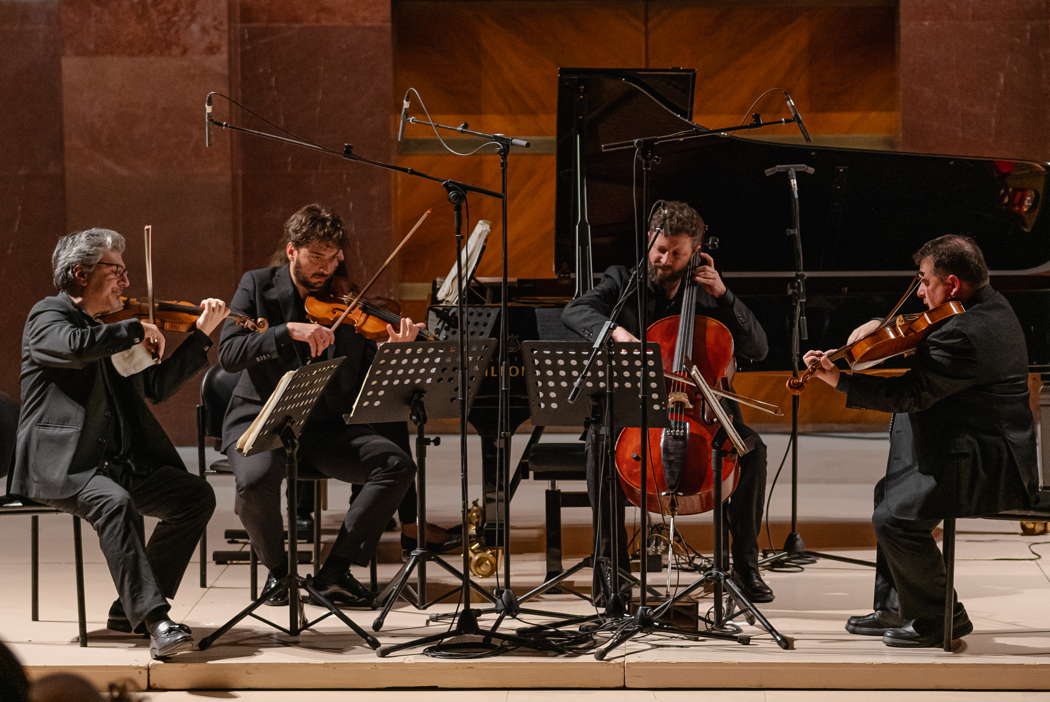
From left to right: Gabriele Pieranunzi, Fabrizio Falasca, Danilo Squitieri and Francesco Fiore performing at the Aula Magna of La Sapienza University in Rome. Photo © 2023 Andrea Caramelli
Brahms returned, in another way, to the strings: he recognized the piano's inability to convey the expressive richness and iridescent timbre typical of strings, and he chooses a new and definitive ensemble, which brings together the strings and the piano. Thus, the Quintet, Op 34, acquired a touch of extraordinary individuality. The composer solved the problem of coexistence between two different phonic entities, reserving for the piano a concertante role of primary importance, and assigning to the strings the task of transmitting, thanks to an infinite series of games and timbre references, the sense of a symphonic-orchestral type of spatiality. This extraordinary nature is the key to understanding chosen by the ensemble at the IUC concert.
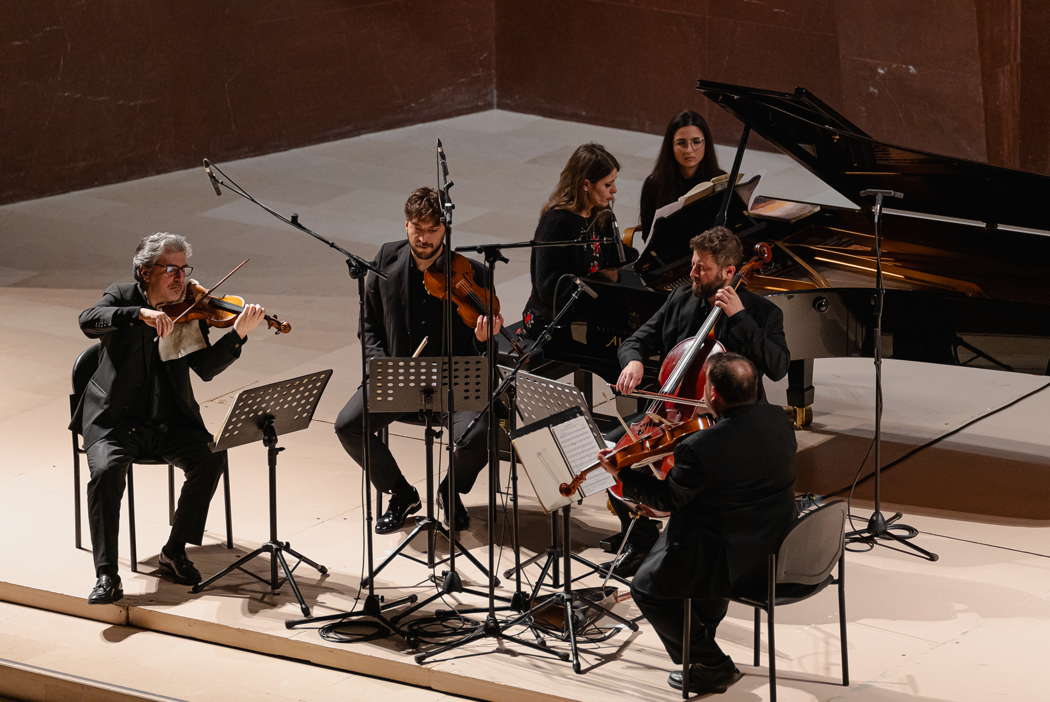
From left to right: Gabriele Pieranunzi, Fabrizio Falasca, Giorgia Tommasi, Tommasi's page turner, Danilo Squitieri and Francesco Fiore performing at the Aula Magna of La Sapienza University in Rome. Photo © 2023 Andrea Caramelli
This fascinated the audience, who responded with real ovations and requests for encores. The ensemble responded with the second movement of the Quintet in E flat major for piano and strings, Op 44, by Robert Schumann - a poignant funeral march.
Copyright © 30 January 2023
Giuseppe Pennisi,
Rome, Italy



